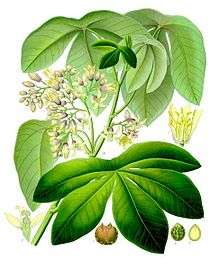Manihot carthaginensis subsp. glaziovii
Manihot carthaginensis subsp. glaziovii, also known as Manihot glaziovii, the tree cassava or Ceara rubber tree, is a species of deciduous flowering plant in the spurge family, Euphorbiaceae, that is native to eastern Brazil.
| Tree cassava | |
|---|---|
 | |
| Scientific classification | |
| Kingdom: | Plantae |
| Clade: | Tracheophytes |
| Clade: | Angiosperms |
| Clade: | Eudicots |
| Clade: | Rosids |
| Order: | Malpighiales |
| Family: | Euphorbiaceae |
| Genus: | Manihot |
| Species: | M. carthaginensis |
| Subspecies: | M. c. subsp. glaziovii |
| Trinomial name | |
| Manihot carthaginensis subsp. glaziovii Allem | |
| Synonyms [1] | |
| |
Description

Common names
- French - manioc de ceara, maniçoba, ceara, caouchouc de ceara
- Portuguese - manicoba
- Swahili - mpira
- Yoruba - gbaguda
Uses
The tree cassava was used a source of rubber, instead of Hevea brasiliensis throughout the world. The plant is introduced largely in the world, but now it is classified as one of the highly invasive plant of the world.[4]
Scientists found various enzymatic and inhibitory activities of tree cassava, which have insecticidal and anti-fungal proteins extracted from the latex of the plant. These proteins are effective against insects such as cowpea weevil, and fungi like Colletotrichum gloesporioides, Fusarium solani and Macrophomina phaseolina.[5] It could be used as graft shoot in a rootstock of edible cassava and increase 10 times the yield per acre.
Invasiveness
The species is invasive in New Caledonia.[6]
References
- "Manihot carthaginensis subsp. Glaziovii (Müll.Arg.) Allem — the Plant List".
- http://www.worldagroforestry.org/treedb2/AFTPDFS/Manihot_glaziovii.PDF
- "Flora of Zimbabwe: Species information: Manihot glaziovii". www.zimbabweflora.co.zw. Retrieved 2020-07-09.
- "Manihot glaziovii in Flora of China @ efloras.org". www.efloras.org. Retrieved 2020-07-09.
- Pereira, Lucilene S.; Gomes, Valdirene M.; Fernandes, Kátia V. S.; Sales, Maurício P.; Xavier-Filho, José (1999). "Insecticidal and antifungic proteins of the latex from Manihot glaziovii Muell. Arg". Brazilian Journal of Botany. 22 (1): 27–30. doi:10.1590/S0100-84041999000100005. ISSN 0100-8404.
- Hequet, Vanessa (2009). Les espèces exotiques envahissantes de Nouvelle-Calédonie (PDF) (in French). p. 17.